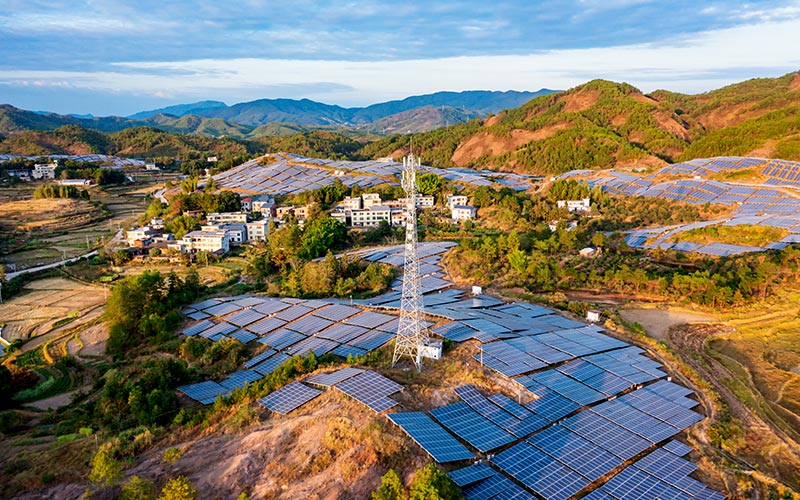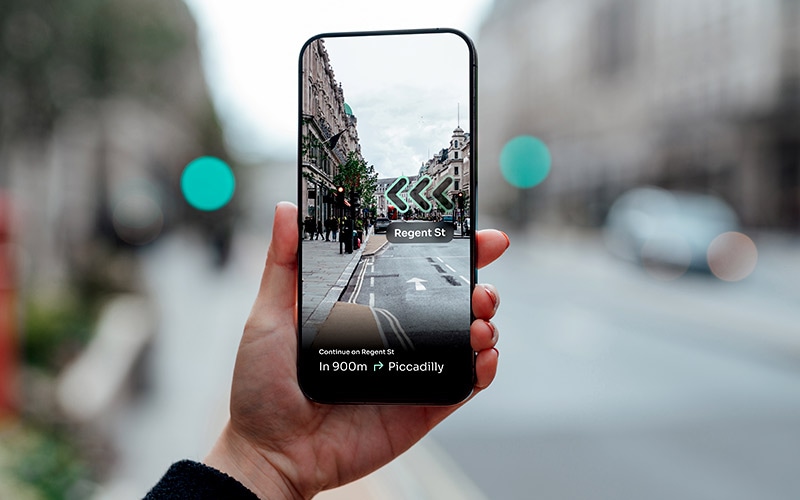5G will drive the new world digital economy
Energy and utility companies are leading the pack in actively developing business cases, services and partnerships around 5G. Fifty-six percent of energy and utility companies are defining use cases for 5G and 20% are already defining their 5G service portfolios along with ecosystem partners, according to a recent Infosys Knowledge Institute survey.1 (Figure 1) It’s not surprising given that the technology can help utilities better “sense and respond” across their networks and customers, a key component of what Infosys has termed Live Enterprise.
Over the past few decades, we have seen a major transformation in the telecom networks, opening new possibilities and paradigms. Mobile phones were first launched in 1980 over the 1G network (otherwise known as first-generation wireless technology), offering voice-only solutions.
2G came about in the 1990s — making texting and MMS a reality. 3G was launched in 2001 with data rates of up to 2Mbps. Seeing this as an opportunity, Apple launched its first iPhone in 2007, and life has never been the same. The 2009 launch of the 4G network, supporting high-speed multimedia with data rates of 100Mbps, gave birth to multiple new industries and business models. The combined need to support new business models, superior experiences and ever increasing devices has driven the constant evolution of the telecommunications network. That brought us to the launch of 5G in 2018.
Figure 1. Utility firms are mostly at early stage of 5G development
Source: Infosys
5G is a big step up from the previous generations. It provides up to 100 times more bandwidth, 20-50 times lower latency and extremely high reliability (URLLC: ultra-reliable low latency communication). As a result, it has the ability to support up to 100 times more connected devices (mMTC: massive machine-type communication), transmitting up to 1,000 times more data at much faster speeds. (Figure2) 5G capabilities can be leveraged by energy and utility companies to help address some key issues faced by the industry. If utilities act now, 5G can make a profound impact in the near future by improving the health and safety of employees, creating new revenue models, reducing costs of asset management, speeding up maintenance and repairs, and facilitating remote field workforce training.
Figure 2. Predicted 5G improvements that could help utilities
Source: Feedback Insights
5G use cases for the utilities industry
Use case 1: Digital field workforce
The utilities industry is asset driven and spends significant time and money on managing and maintaining its assets. Today, most of this is done manually by thousands of trained field technicians inspecting each site over vast geographical spans and complex urban neighborhoods.
This is both expensive and a major risk to health and safety. In addition, lack of adequate technician training could have a severe impact on customer experience, leading to low first time resolution of faults.
All these issues can be addressed if the field technician is digitally enabled with the help of 5G-powered AR/VR/MR solutions. Imagine a field force technician on-site, needing remote help from an expert. If equipped with a VR headset and an ability to stream high definition video of the equipment, the technician will be able to seek expert guidance remotely and fix the issue in a single truck roll.
5G gives utilities the ability to roll out digital training using VR/AR or mixed reality, so workers can use a digital twin to learn new skills or diagnose faults without coming back to base
Training new or existing workers is another problem for utilities. A utility can have 10,000-20,000 workers in the field workforce. It’s difficult to get that many people back to base for training. Also, according to a 2017 study by the U.S. Department of Energy, 25% of the U.S. workforce in electric utilities will be ready to retire within the next five years.2
All of this needs very high bandwidth to support 4k/8k videos, which are among the core value propositions of the 5G network.
Use case 2: Smart “everything”
For a city to be smart, it will need to view and control millions of IoT devices and machines remotely. For example, deploying an AI-enabled traffic management grid needs collection of real-time data from millions of beacons and sensors across the city and an ability to control the traffic signals in real time, based on predictive algorithms. The current wireless networks (Wi-Fi or 4G) are unable to cater to this volume of devices and data, and do not have the reliability or latency to support real-time, mission-critical operations. Similarly, for a city to be able to deploy remote video surveillance, it needs a network that can support extremely high bandwidth with very low latency. Also, different types of services may have different needs for quality of service (QoS). The same concept applies to smart homes, smart buildings and smart neighborhoods. 5G is just the right network to be able to support these requirements via high bandwidth, URLLC and the ability to provide network slicing (Figure 3), since it is a software-defined network (SDN).
All of these are potential new revenue streams for utility companies. The smart home market is expected to grow 7.5% a year — hitting $262.63 billion in 2025.3 According to one report, smart cities will create $100 billion in revenue for utilities.4 As electricity distributors run poles and wires to all parts of the cities and neighborhoods, they could leverage their assets to provide smart surveillance solutions or smart lighting solutions to communities, law enforcement agencies and enterprises. 5G will be a key enabler for utilities to commercialize these revenue models. In addition, 5G allows utilities the opportunity to improve customer experience, including by reducing costs to serve and improve health and safety, since many operations can be managed remotely and in real time by leveraging a 5G network.
Figure 3. 5G network slices create networks tailored to meet different industry requirements
Source: Infosys
Use case 3: Distributed energy resources
Today, renewable energy accounts for a third of global power capacity. According to new data from the International Renewable Energy Agency, renewable energy capacity grew globally by 171 gigawatts in 2018. Sixty-one percent of new renewable energy installations were in Asia. Renewables contribute 17% of the energy generated in the U.S. In more than half the states, electric companies are required to produce a percentage of energy using renewable resources. Governments around the world are encouraging citizens to use renewable sources of energy. More than 2 million homes in Australia are solar powered5 — that’s 20% of all the homes in Australia. Sweden gets 54.5% of its energy from renewable sources. Finland isn’t far behind, with 41%.
As millions of consumers and enterprises turn into small electricity producers, they would like to share the excess energy produced with the grid or among each other. This presents an opportunity for utility companies to create and run a distributed energy grid. Currently, net metering is used to accommodate two-way power flows.
Utility companies require a distributed energy resource management platform. This platform should be able to manage energy flows from different sources and accommodate two-way power flows — homes to grid and homes to homes. The next-generation smart grid will send back data that utilities can use to optimize their operations. The current 4G network will not be able to support all of those devices at scale. There will be billions of devices communicating with each other and sharing data every millisecond. The energy management system should be able to handle all these requirements and do so in real time. 4G brought these opportunities closer to reality, but data transmission speeds and bandwidth limitations are currently preventing these possibilities from reaching their full potential.
5G, with its capabilities of ultralow latency and large bandwidth, can accelerate grid modernization. 5G enables real-time collection and analysis of large amounts of data from various devices such as power plants, transmission lines, meters and many more
This can help the grid predict energy demand and detect outages. Ultralow latency can help automate power flow switching, load management and voltage stabilization, making it truly intelligent and efficient. Real-time data management through 5G will also enable flexible billing systems using two-way power flows. 5G will play an important role in the scaling of community participation and integration of renewable resources in seamless energy distribution.
Use case 4: Aerial imagery for vegetation management
Faulty electric infrastructure is one of the major causes of wildfires.6 The 2017 California wildfire that claimed 44 lives and burned at least 245,000 acres was caused by faulty electric lines coming in contact with dry vegetation.7 The utility company involved agreed to pay $11 billion to resolve insurance claims from wildfires in 2017 and 2018. In addition, power outages cost billions of dollars to the economy.8 However, it is physically impossible to monitor electric lines passing through millions of miles of forest, desert and mountains.
It generally takes years for a utility company to survey its entire territory. The inspections are done manually by following the electric lines on the road or by helicopter/UAVs/drones. This makes for very slow preventive action. LiDAR (light detection and ranging)-based technology and aerial imagery to capture data are not being used to their full potential. In most cases, drones capture information that is then inspected offline. If there are any issues, the drone or helicopter goes back to get additional information, by which time it may be too late. With 5G, a large amount of data can be transmitted at very high speed. Drones can transmit high-definition videos and images in real time, which can be compared with the older images using sophisticated AI/ML algorithms. If an anomaly is detected, the drones can zoom in immediately to capture 360-degree images of the impacted area for further assessment and corrective action.
This could save millions of dollars for utilities in maintenance costs and by preventing catastrophic damage to environment and life.
Barriers and challenges
Energy and utility companies navigating the various stages of 5G adoption can expect to face a few barriers and challenges. 5G’s significantly higher bandwidth and low latency bring the unique ability to support mMTC and MIoT (massive IoT). The higher number of end point connections leads to quantum times more data being generated and transferred across the 5G network. As most utilities support critical infrastructure, ensuring data security will be one of the biggest challenges for the industry.
As utilities move toward renewable energy, they must become very careful about the return on capital investments. Selecting and prioritizing 5G use cases to deliver the desired ROI is also a key challenge for utilities.
Finding employees with the skills needed to create and monetize use cases on 5G-related technologies will be another challenge for the energy and utility industry. Most use cases will require skills in digital technologies such as AI/ML, AR/VR and SDN. These are still niche skills, and finding people who have them will be key.
The broader regulatory concerns around interoperability across standards and networks will remain across all industries. As with every network evolution, governments, industry forums and service providers will continue to work through this challenge.
Translating concepts to reality
There’s a lot to do before utilities can fully realize the benefits of 5G. According to our research, energy and utility companies are leading the pack when it comes to use case definition, with 39% involved in the prototype stage, a much higher percentage than in any other industry (Figure 4). But in terms of commercial execution, utilities lag behind, with only 7% of companies at this stage of maturity.
Our research also found that systems integrators partners are considered just as important as network operators when it comes to bringing the 5G ecosystem together for commercial execution of the use cases. This makes sense when one considers the number of different technologies, business strategies, and operating models and processes that have to be designed and implemented to make 5G effective. Utilities will need to work with a wide range of key digital skills such as experience design, data, AI/ML, IoT, blockchain, cloud and edge computing, SDN/NFV, and security, making the role of systems integrators even more prominent.
This is where collaborative innovation initiatives such as Infosys’ 5G Living Labs can help. These labs provide a platform for industries to come together and experiment using a fully simulated 5G network to establish desirability, feasibility and viability of a use case.
The utility industry is testing 5G, but the utilities that get there first are the ones that will make the most gains transforming their operation. The faster utilities make the move to 5G, the more competitive they will be. By leading the pack with 5G, a utility company will lead the market in new business models and reduction of operating costs.
Figure 4. Most Energy & Utility firms are evaluating or prototyping 5G, Compared with other industries that are developing services
Source: Infosys
| Wait and Watch | Evaluating business opportunities | business case Formulation | Build use cases | Prototype Stage | Exploring service possibilities | seeking partnerships to explore service offerings | |||
| No Finalized strategy or wait and watch | Currently in the process of building business case | Currently in the process of defining use cases | Currently in the process of developing service portfolio | ||||||
| Criteria for identifying opportunities | |||||||||
|
|
|
|
|
|||||
References
- “State of 5G — The Road Ahead,” Infosys, March 2019, https://www.infosys.com/services/engineering-services/insights/state-of-5g-road-ahead.html
- “Preparing for the Aging Utility Workforce,” IBM, January 2018, https://www.ibm.com/blogs/insights-on-business/energy-and-utilities/preparing-aging-utility-workforce/#_edn1
- “Future of Smart and Connected Homes, 2019-2025 Partnerships Between Smart-Home Product Providers and Utility, Telecom, Insurance, and Online Retail Companies are Crucial for Mass Market Adoption,” researchandmarkets.com, October 2019, https://www.prnewswire.com/news-releases/future-of-smart-and-connected-homes-2019-2025-partnerships-between-smart-home-product-providers-and-utility-telecom-insurance-and-online-retail-companies-are-crucial-for-mass-market-adoption-300934024.html
- Smart cities to generate $100 billion in revenue for utilities, Smart Energy International, February 2019, https://www.smart-energy.com/industry-sectors/smart-grid/smart-cities-to-generate-100-billion-in-revenue-for-utilities-by-2027/
- “Number of Australian homes with rooftop solar tops 2 million … and counting,” Clean Energy Council, December 2018, https://www.cleanenergycouncil.org.au/news/number-of-australian-homes-with-rooftop-solar-tops-2-million-and-counting
- “Rethinking Utility Vegetation Management, POWERGrid International, May 2018,https://www.elp.com/articles/powergrid_international/print/volume-23/issue-5/features/rethinking-utility-vegetation-management.html
- “PG&E equipment and power lines caused Northern California wildfires, says Cal Fire,” Curbed San Francisco, June 2018,https://sf.curbed.com/2018/6/8/17443508/santa-rose-napa-fire-wildfire-pge-report-findings
- “Berkeley Lab estimates sustained electric power interruptions cost the U.S. approximately $44 billion annually — a 25% increase since 2006,” Electricity Markets & Policy Group, October 2018, https://emp.lbl.gov/news/berkeley-lab-estimates-sustained-electric








